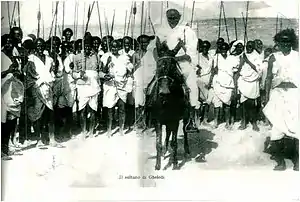Osman Ahmed
Osman Ahmed (Arabic: عثمان أحمد) was a Somali ruler. He was the fifth and final Sultan of the Geledi Sultanate. Osman Ahmed is considered less illustrious than his predecessors and Gobroon power weakened considerably under his rule. He was the son of Sultan Ahmed Yusuf and succeeded his father after his death.[1] Although, considerably weaker than his forebears he was still the most powerful ruler in the region and was credited for defending the Rahanweyn territory by repulsing an invasion from the Ethiopian Empire and Dervish State.
| Osman Ahmed عثمان أحمد | |
|---|---|
 Sultan Osman Ahmed (mounted) & his mamluk soldiers | |
| Sultan of the Geledi | |
| Reign | 1878–1911 |
| Predecessor | Ahmed Yusuf Mahamud |
| Successor | Monarchy abolished |
| Born | Afgooye, Geledi Sultanate |
| Died | Early 1920s Italian Somaliland |
| Dynasty | Gobroon Dynasty |
| Religion | Islam |
History
Reign
The succession of Osman Ahmed in the 1880s brought the Geledi Sultanate a man of lesser desires and minimal diplomatic skills than his illustrious forefathers. Osman, for example, did nothing to stop the Bimaal when they blockaded a branch of the Shabelle River thus causing difficulties to Geledi's agricultural subjects downriver. During Osman's rule, numerous former allies and subjects began to claim their independence from Geledi hegemony; and the religious leaders of nearby Mereerey began to expand their influence over groups once-loyal to the Gobroon dynasty.[2]
Despite these complications, Osman's inherited Baraka (grace) as a member of the noble Gobroon lineage which was still respected by many ordinary Somalis in the region. We have seen how Sultan Osman Ahmed was given much credit for repelling the Ethiopian invasion. In the mid-1890s, Osman's forces had still been strong enough to defeat the rebellious Hintire clan down the river. And Cecchi apparently sensed that Sultan Osman remained a force to be reckoned with, for the devastating Lafoole expedition had originated with Cecchi's plans for an Italian-Geledi partnership. The Italian investigation of the Lafoole incident produced conflicting proof about the complicity of the Geledi in the affair. Acting-administrator Dulio felt that the young men of the Geledi clan were fiercely against the Italian presence, whereas their elders wanted some sort of accommodation. The authorities had received a letter from the wealthy landlord Aw Nur Ahmedow denying Geledi involvement in the attack of Cecchi's expedition, but at the same time news reached Mogadishu that a hostile Sheikh was attracting large crowds in Balguurey and Ceel Qoode (Elqode). The administer could only conclude that Sultan Osman had known of the plans for the attack at Lafoole but had stopped his followers from getting involved. In fact, the Sultan was in an unfavourable position. Within his own Gobroon lineage, counselors were pressuring him to stand against the Italians and so restore his status among neighbouring clans who were not happy with the foreign presence thus it may not be surprising if he did participate in the Battle of Lafoole in 1896 where the Italians faced their biggest and most humiliating defeat.[3]
Peace treaty with Bimaal
Sultan Osman did not want to repeat the same mistake as his father and grandfather and decided to make peace with the Bimaal clan. He lifted sanctions against Merca and allowed them to serve the hinterland which boosted wealth between the Sultanate and the city-state. Sultan Osman was praised for creating peace in South Somalia.[4]
Battle of Hudur
Many Somalis were somewhat willing to join and/or support the Dervish Army led by Mohammed Abdullah Hassan simply because of his anti-foreign stance. Sultan Osman and many other leaders in the South Somalia regions had begun opening diplomatic channels for negotiation with the Dervish. Despite mutual admirations, negotiations foundered due largely to the Gobroon Dynasty and others distrust of the Dervish as a result of the Dervish army slaughtering Maay speaking people and the personal feud assassination of Sheikh Uways al-Barawi by the Dervishes, Uways was a prominent Sheikh in the region. Over 30,000 soldiers from almost all the Maay-speaking tribes led by Sultan Osman inflicted a stunning defeat and repelled the Dervish from all Geledi Sultanate's territory at the Battle of Hudur.This defeat and, the British and the soldiers of Haaji Waraabe ("Haji the Hyena") striking the Dervish settlements in North Somalia had ended the reign of the Dervish and Mohammed Abdullah Hassan.[5]
Treaties with Italians
Osman signed treaties with the Italians for the protectorate in 1902.[6] However, Uways al Barawi from Barawa was not happy with the Italian presence and would organize a movement known as the Muslim Brotherhood leading the Banadir revolt in 1906, but it was crushed by Italian forces in 1908.[7][8] By 1911, the small remnant kingdom of the once-powerful Geledi state formally ended and was incorporated under direct Italian administration. Sultan Osman remained a notable figure and the leading traditional figure in Afgooye and would die in the early 1920s.[9]
See also
Notes
- Cassanelli, p.149.
- Cassanelli, Lee (1982). The Shaping of Somali Society. p. 208. ISBN 9780812278323.
- Cassanelli, Lee (1982). The Shaping of Somali Society. p. 209. ISBN 9780812278323.
- Gundel, Joakim (2006). The predicament of the 'Oday': The role of traditional structures in security, rights, law and development in Somalia. Danish Refugee Council & Novib/Oxfam. p. 28.
- Divine madness: Moḥammed ʻAbdulle Ḥassan (1856-1920) page 83
- Somali Sultanate: the Geledi city-state over 150 years, pg 92
- Mukhtar, Mohamed Haji (25 February 2003). Historical Dictionary of Somalia. p. 210. ISBN 9780810866041. Retrieved 2014-02-15.
- The social structure of southern Somali tribes, Virginia Luling, pg. 204
- The social structure of southern Somali tribes, Virginia Luling, pg. 204
References
- Cassanelli, Lee Vincent (1973). The Benaadir past : essays in southern Somali history. University Microfilms International.
- Luling, Virginia (2002). Somali Sultanate: the Geledi city-state over 150 years. Transaction Publishers. ISBN 0-7658-0914-1.